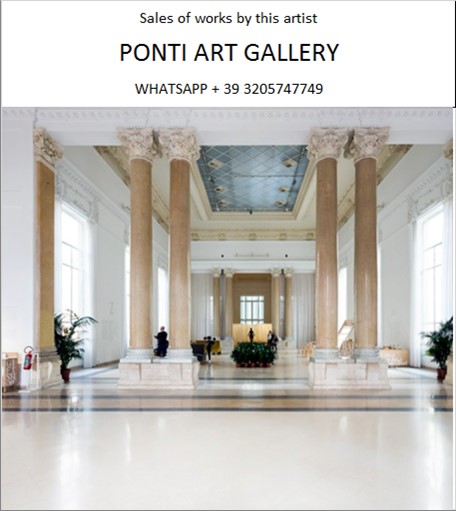Ponti Art Gallery is interested in buying and selling works
of art by this artist.

Raymond Hains Biography
Raymond Hains was a French visual artist whose innovative and influential work spanned several decades of the 20th century. Born on November 9, 1926, in Saint-Brieuc, France, Hains was a key figure in the post-war European art scene and a founding member of the Nouveau Réalisme movement.
Hains' early interest in art led him to enroll in the École des Beaux-Arts in Rennes at the age of eighteen, where he studied sculpture. However, his fascination with photography soon took precedence, and he left for Paris in 1945. There, he began an apprenticeship with Emmanuel Sougez, a photographer for the magazine France Illustration. During this period, Hains started creating photograms and solarizations on paper, and he met André Breton, the founder of Surrealism, to whom he showed his work.
His first abstract photographs were taken using a circular reflector equipped with small mirrors, which multiplied and fragmented the subject matter. These early experiments with photography and film in the 1940s and 1950s laid the groundwork for his later artistic endeavors. Hains' work during this time was influenced by prewar Dada and Surrealism, and he created hypnagogic abstract photographs, often made with distorting mirrors, and short movies that captured the essence of Parisian walks.
In 1949, Hains met Jacques de la Villeglé, with whom he would later collaborate extensively. Together, they began to explore the potential of found objects in art, particularly torn posters and advertisements they collected from the streets of Paris. This practice led to the creation of décollages, or 'paintings' made from these materials, which they exhibited in 1957. The décollages were seen as a challenge to the subjectivity of American action painting and the French Art Informel movement.
Hains' work with torn posters was a turning point in his career and became one of the founding gestures of Nouveau Réalisme. This movement, which he helped establish in 1960 along with artists like Arman, François Dufrêne, Yves Klein, Jean Tinguely, and critic Pierre Restany, sought to incorporate elements of the real world into art, moving away from traditional painting and sculpture.
Throughout the 1960s, Hains continued to innovate, creating works that played with language and verbal gags, which became key components of his art. He was also known for his Macintoshages, digital montages that he began working on in the late 1990s, juxtaposing computer-based texts and images in automatic arrangements.
Hains' approach to art was characterized by a constant challenge to perceptions and definitions. He opened up new "construction sites" in his work, which he revisited regularly. His methodology combined with a lifestyle and a way of talking that left a mark on everyone who entered the Hainsian world. Among his notable works were the hypnagogic photographs and the abstract photos made through fluted glass, which he applied to other mediums, including cinema and letterist poetry.
Hains was also known for his playful and humorous works that explored ideas around philosophy, literature, and linguistics. His art was a joyful speculation on literary and geographical coincidences and his own immediate environment, taking ever-new forms. Each work proliferated with double entendres and unsuspected connections that could only be decrypted by reference to Hains' universe.
In addition to his artistic practice, Hains was a sociable yet highly private man who divided his last 30 years between Nice and Paris. He was a charismatic figure who produced spectacular photographs recording a city transfigured by its ephemera. Hains was also an insatiable documenter of everyday life, always with his camera strung around his neck.
Raymond Hains passed away on October 28, 2005, in Paris, leaving behind a legacy that continues to unfold in the collective imagination. His work is represented in many museums in France and abroad, and he was posthumously selected as an artist for the main exhibition of the 57th Venice Biennale in 2017. Hains' influence on contemporary art remains significant, as his work transgresses and explodes established theories, offering a unique vision that continues to inspire artists today.
Raymond Hains Quotes and Sales
of Works
Ponti Art Gallery selects and deals with paintings by the
artist. Upon request, we provide free estimates and
evaluations, communicate prices, quotations, and current
market values.
If you are interested in BUYING or SELLING works by the
artist, contact us immediately.
If you wish to sell or receive an evaluation of the
works:
Send us a frontal photo of the painting, one of the back,
and one of the signature. Also, indicate the dimensions of
the work. Inform us about the purchase origin of the work
and any kind of available documentation (purchase
receipts, certificates of authenticity, publications). One
of our operators will respond to you on the same day. We
guarantee maximum confidentiality and extreme
professionalism.
If you wish to purchase works by the painter: Contact us
and let us know your request. We will inform you about the
available works. We also offer the possibility to
subscribe to our NEWSLETTER, through which you will be
informed at the beginning of each month about the latest
acquisitions of the art gallery.
You can send us pictures of the work:
